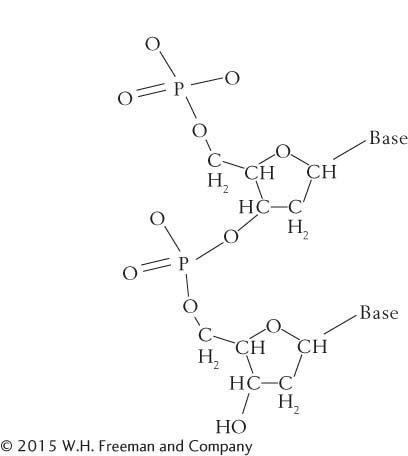Chapter 8
No, the student has not demonstrated that transformation has taken place. A single mutation could convert the IIR strain into the virulent IIS strain. Thus, the student cannot determine whether the conversion from IIR to IIS is due to transformation or to a mutation. Additionally, the student has not demonstrated that the heat was sufficient to kill all the IIS bacteria. A second useful control experiment would have been to inject the heat-
killed IIS into mice and see if any of the IIS bacteria survived the heat treatment.
The phosphate backbone of DNA molecules typically carries a negative charge, thus making the DNA molecules attractive to the positive pole of the current.
Organism and tissue (A + G)/(C + T) (A + T)/(C + G) Sheep thymus 1.03 1.36 Pig liver 0.99 1.44 Human thymus 1.03 1.52 Rat bone marrow 1.02 1.36 Hen erythrocytes 0.97 1.38 Yeast 1.00 1.80 E. coli 1.04 1.00 Human sperm 1.00 1.67 Salmon sperm 1.02 1.43 Herring sperm 1.04 1.29 The (A + G)/(T + C) ratio of about 1.0 is constant for these organisms. Each of them has a double-
stranded genome. The percentage of purines should equal the percentage of pyrimidines in double- stranded DNA, which means that (A + G) = (T + C). The (A + T)/(C + G) ratios are not constant. The number of A−T base pairs relative to the number of G−C base pairs is unique to each organism and can vary among the different organisms. The (A + G)/(T + C) ratio is about the same for the sperm samples, as should be expected. As in part b, the percentage of purines should equal the percentage of pyrimidines.
Adenine = 15%; guanine = 35%; cytosine = 35%.
Neither 5′ carbon of the two sugars is directly linked to phosphorus.
Neither 5′ carbon of the two sugars has an OH group attached.
Neither sugar molecule has oxygen in its ring structure between the 1′ and 4′ carbons.
In both sugars, the 2′ carbon has an OH group attached, which does not occur in deoxyribonucleotides.
At the 3′ position in both sugars, only hydrogen is attached, as opposed to an OH group.
The 1′ carbon of both sugars has an OH group, as opposed to just a hydrogen attached.

No. The flow of information predicted by the central dogma is from DNA to RNA to protein. An exception is reverse transcription, whereby RNA encodes DNA. However, biologists do not currently know of a process in which the flow of information is from proteins to DNA, which is required by the theory of the inheritance of acquired characteristics.
Prokaryotic chromosomes are usually circular, whereas eukaryotic chromosomes are linear. Prokaryotic chromosomes generally contain the entire genome, whereas each eukaryotic chromosome has only a part of the genome: the eukaryotic genome is divided into multiple chromosomes. Prokaryotic chromosomes are generally much smaller than eukaryotic chromosomes. Prokaryotic chromosomes are typically condensed into nucleoids, loops of DNA compacted into a dense body. Eukaryotic chromosomes contain DNA packaged into nucleosomes, which are further coiled and packaged into structures of successively higher order. The condensation state of eukaryotic chromosomes varies with the cell cycle.
(a) 3.2 × 107; (b) 2.9 × 108.
Although the chemical composition of the genetic material may be different from that of DNA, it more than likely will have properties similar to those of DNA. As stated in this chapter, the genetic material must contain complex information, replicate or be replicated faithfully, and encode the phenotype. Even if the material on the planet is not DNA, it must meet these criteria. Additionally, the genetic material must be stable.
Tubes 1, 4, and 5. The DNA of the bacteriophage contains phosphorus and the protein contains sulfur. When the bacteriophages infect a cell, they inject their DNA into the cell, but the protein coats stay on the surface of the cell. The protein coats are sheared off in the blender. After centrifugation, the protein coats remain in the fluid, while the cells containing the phage DNA are at the bottom of the tube. Thus, bacteria infected with 35S-
labeled phage will have radioactivity associated with the protein coats, whereas bacteria infected with 32P- labeled phage will have radioactivity associated with the cells.